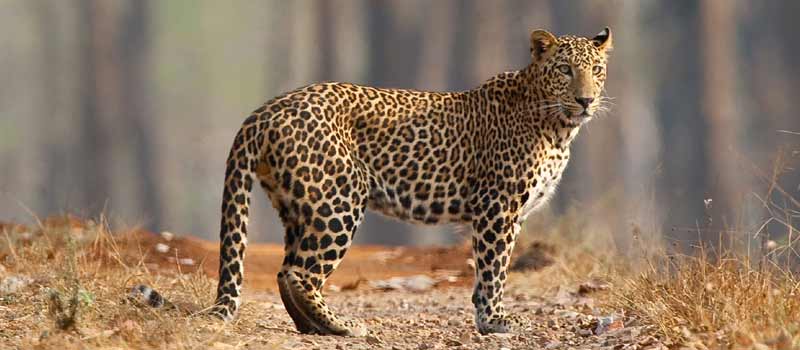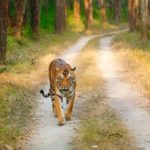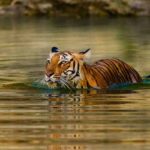5 Best Leopard Safari Park india The Indian Leopards are the most impressive wild cat, flexible and opportunistic hunters, living in and around the Indian subcontinent’s urban environment, buffer zones and protected habitats. First ever leopard census in India shows impressive numbers, 12,000 leopards live in the entire country’s wilderness forest.
In the state of Madhya Pardesh, Karnataka, Maharashtra, Mudumalai National Park, Rajasthan, Uttarakhand, Chhattisgarh, Tamil Nadu and Assam the largest number of wild Indian leopards is found.
Nagarhole National Park, Nagzira Wildlife Sanctuary, Jim Corbett National Park, Rajaji National Park, Mouling National Park, Gir Forest National Park, Sariska Wildlife Sanctuary, Bandipur National Park and Kanha National Park are the most popular National Parks in India to spot wild leopards.

1. Jawai Leopard Reserve – Pali, Rajasthan
The Jawai hills located in Rajasthan’s Pali district are one of the locations that offer scarce leopard sights that roam freely out in the open. Often known as the hills of the leopard, they are surrounded by Jawai Bandh and grasslands, while the valley is dominated by the Aravali range. Considered one of the lesser known tourist destinations, this location deserves considerably more coverage than it receives.
Some hills have been formed by lava millions of years ago and now the area’s natural caves are home to leopards and other wild animals. The Jawai leopards not only live together, they also live in peace with humans, which directly contradicts the fact that the big cats are solitary creatures. It’s one of the best places to spot a leopard during the day, easily.
Besides the leopard safari, the place is also popular for bird watching, as many migratory birds live in the Jawai dam. Around Jawai are the Jawai Hills Leopard Sanctuary, Kambeshwar Ji Leopard Sanctuary, and Jawai Dam Crocodile Sanctuary. Many wild animals like wolves, jackals, striped hyenas, feral cats, and Chinkaras are abode in the jungles. Jawai’s unexplored wildlife sanctuaries are fairly more popular among foreign tourists.
In addition to spotting leopards and other wild animals there is a temple built in the caves called DevGiri. This temple is dedicated to Kalka Devi, and translates its name into the Own Hills of God. Leopards are also seen wandering around temple cellars and stairs, a beautiful sight to catch in your camera.
Jawai is a special, mystifying place that stands as a monument to animal and human harmony. The fact that Jawai leopards display an odd behavior makes it all the more interesting. For those who wish to take a walk across the jungles and see Jawai’s wilderness, there are many safari camps. You may also take a look at the rural populace’s lives, the animals that graze in the fields, and the picturesque location that is a treat for the eyes.
2. Jhalana Leopard Safari Park – Jaipur, Rajasthan
Jhalana Park is situated in an industrial area called Malviya nagar, in Jaipur. It’s a small park with Leopard as primary predator in the area. Blue bulls, spotted deers, stray dogs, squirrels and other herbivores form the preybase. This Jhalana wildlife park has inside a small local temple that attracts a lot of tourists, and is divided by a small fencing with the park. Leopards are seen wandering around the temple in the early morning and at night time. This small area of Jhalana Wildlife Park features more than 30 leopards. Government has started online booking of Jhalana safari, which must be done well in advance at the entrance. Due to frequent observations of leopards, the Jhalana wildlife park has been at the forefront for 2-3 years. Offering some amazing sightings on photograph. It also has lots of birds around, winters in the Jhalana wildlife park are the best season to do birding.
3. Kumbhalgarh Wildlife Sanctuary – Rajsamand, Rajasthan
Khumbhalgarh Wildlife Sanctuary is situated in Rajsamand, Rajasthan district. The sanctuary extends over an area of 610.5 sq km that includes parts of the districts of Rajsamand, Udaipur, and Pali. It also covers four Aravallis-Kumbhalgarh Range hill and mountain ranges; Sadri Range; Desuri Range; and Bokhada Range. The Kumbhalgarh Wildlife Sanctuary can either be explored by a jeep safari, trekking or by riding a horse.
Rajasthan’s wildlife sanctuary is recognized as the home of a number of animals including several endangered species. In the sanctuary, the main predator is the leopard who preys on animals such as sambhar, nilgai, chausingha (the four horned antelope), chinkara and Indian hare. There are many birds to be seen in the Kumbhalgarh Wildlife Sanctuary, the most famous of which is spotted here is the grey jungle fowl.
4. Satpura National Park – Madhya Pradesh
Set amidst the Satpura range in Madhya Pradesh district of Hoshangabad, Satpura National Park is a pristine wildlife habitat spread over an area of 524 sq. 5. 5. It was first introduced in the year 1981 by popular bird watcher Dr. Salim Ali. During the same year, Bori Sanctuary (486 sq km) and Panchmarhi Wildlife Sanctuary (417 sq km) protected an area of 1427 sq km. Creating a rare highland ecosystem in Central India. The park was added to the Tiger Project Network by 1999, and became the Tiger Reserve Bodi-Satpura. Okay, this place captivates one who is interested in archaeology as there are plenty of ancient period rock shelters embellished with beautiful paintings.
On the way you’ll find the rugged landscapes commemorated with sandstone peaks, narrow gorge, ravines and dense forests that make it an inimitable nature creation. It is the place where all wildlife buffs have to visit to enjoy the view of the jungle, beautiful hilly terrains, rivulets and unswinged forest etc. Very rich in biodiversity, Satpura’s wildlife covers a vast array of flora and fauna including rare species of mammals, birds, reptiles and plants.
5. Bandipur National Park – Karnataka
Bandipur National Park was once the Maharaja of the Kingdom of Mysore hunting reserve. Established as a forest tiger reserve under the Tiger Project in 1974, Bandipur is the most prominent national park in the southern Indian state of Karnataka, and is best known for its varied wildlife that boasts various biomes in the dry deciduous forest. It is considered as one of the best managed parks of India.
The park stretches over an area of 874 sq km with a great objective of protecting endangered species such as tigers and elephants in this region, as well as preserving and restricting the over-use of sandalwood trees in the reserve. Around 80 km from Mysore City on the way to Ooty, one of the area’s main hotspots, During the year Bandipur National Park brings a warm and pleasant climate with a typical temperature range of 24 to 28 ° C to enjoy the visitors on a wonderful wildlife tour. Monsoon here is erratic but it usually rains between June and September to bring more lush varieties around the reserve areas.
You can safely lodge and camp in the area, while enjoying the safari tours in Bandipur.








